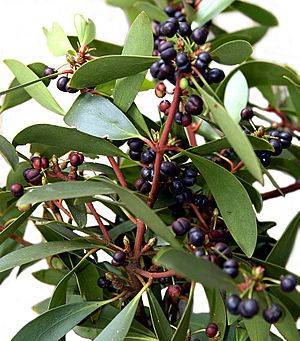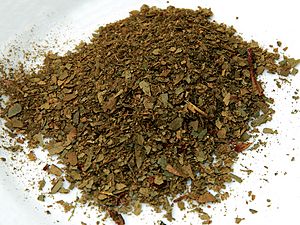Tasmannia lanceolata facts for kids
Quick facts for kids Tasmannia lanceolata |
|
|---|---|
 |
|
| Tasmannia lanceolata Mount Donna Buang, Victoria, Australia |
|
| Scientific classification | |
| Genus: |
Tasmannia
|
| Species: |
lanceolata
|
| Synonyms | |
The Tasmanian pepperberry (scientific name: Tasmannia lanceolata) is a special plant found in south-eastern Australia. It's also called mountain pepper or Cornish pepper leaf. This plant is a shrub, which is like a small tree, and it can grow from 2 to 10 meters tall.
You can find Tasmanian pepperberry growing in woodlands and cool, wet rainforests. Its leaves have a nice smell and are shaped like a spear (this is called lanceolate). They are usually 4 to 12 centimeters long and have a lighter color on the underside. The stems of the plant are often red. In summer, small cream or white flowers appear. After the flowers, black, round berries grow in autumn. These berries are about 5 to 8 millimeters wide. Interesting fact: there are separate male and female Tasmanian pepperberry plants!
A French scientist named Jean Louis Marie Poiret first described this plant. Later, in 1969, A.C. Smith gave it its current scientific name, Tasmannia lanceolata. Before that, it was known as Drimys lanceolata. You can find this plant in Tasmania, Victoria, and as far north as Barrington Tops in New South Wales. It likes to grow in damp, sheltered areas within rainforests.
Contents
What Is Tasmanian Pepperberry Used For?
The Tasmanian pepperberry plant has a special ingredient called polygodial. This is what gives it its unique peppery taste! Both the leaves and the berries of the plant are used as a spice, usually after they have been dried.
Long ago, when Australia was first settled by Europeans, Tasmanian pepperberry was used as a substitute for regular pepper. Today, it's become a popular bushfood ingredient. People add it to many different dishes, like curries and cheeses. It's even used to flavor wasabi in Japan!
The berries taste sweet and fruity at first, but then they leave a lasting peppery feeling in your mouth. Dried Tasmanian pepperberry leaves and berries can also help stop food from spoiling. They also have many antioxidants, which are good for you. Some types of pepperberry plants are grown specially on farms to make sure they are safe for people to eat.
Growing Tasmanian Pepperberry
You can grow Tasmanian pepperberry as a garden plant because it looks nice. Its berries are a favorite food for birds, including Currawongs. You can start new plants from cuttings or from seeds. This plant likes soil that drains well and is a bit acidic. It also prefers some shade. However, it can be sensitive to a plant disease called Phytophthora cinnamomi.
There are also special types of Tasmanian pepperberry grown for gardens. One is called 'Mt. Wellington', which is a smaller plant with new leaves that are a coppery color. Another is 'Suzette', which has leaves with different colors or patterns.
Images for kids
-
Tasmannia lanceolata
Mount Donna Buang, Victoria, Australia
See also
 In Spanish: Tasmannia lanceolata para niños
In Spanish: Tasmannia lanceolata para niños




